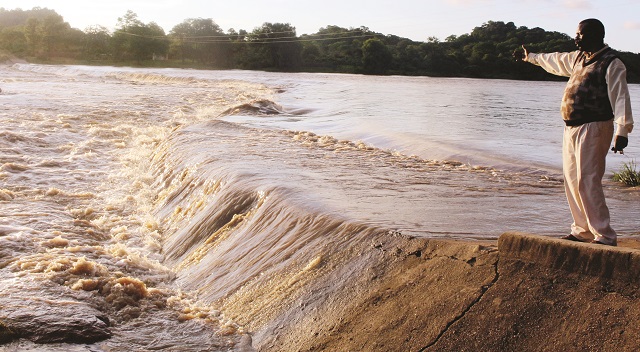Will current Zim floods surpass Cyclone Eline levels?

Sifelani Tsiko
COULD the recent storms and floods that have severely affected most of the country resulting in damage and widespread persistent flooding surpass the scale of the Cyclone Eline-induced floods of the 1999-2000 era which were the worst in the living memory of Zimbabwe?
Could the current torrential rains crush the previous records in terms of rainfall intensity, flooding, loss of lives, damage and human displacement?
Weather and climate experts all agree that the amount of rain has been absolutely extraordinary this season especially as Zimbabwe and the entire region emerge from one of the worst droughts in decades.
Professor Desmond Manatsa, a senior lecturer and chairman of the Geography Department at Bindura University of Science Education, told Zimpapers Syndication that there is a need to first differentiate between the normal Inter-Tropical Convergence Zone rains and the rare cyclone-induced ones before an effective comparison is made.
He says the bulk of the rains that fall in Zimbabwe come due to the seasonal shift of the ITCZ coupled with rare and episodic occurrence of cyclone-induced rains.
The ITCZ is described as a zone that encircles the earth and is roughly parallel to the Equator. It moves north and south following the sun. The ITCZ brings cyclonic rainfall to Zimbabwe during the January-December months.
In recent months, rivers have swollen from the rains. Several rivers have flooded but not to the record levels set during the Cyclone Eline-induced flooding some 16 years ago.
The cyclone-induced floods in the 1999/2000 season claimed the lives of more than 700 people and left more than 500 000 people homeless and caused over $1 billion of infrastructural damage in Zimbabwe and Mozambique, according to a ReliefWeb report in 2001.
During this period, floods resulted in the loss of livestock, destruction of bridges such as Kairezi, Hoya and Chadereka in Muzarabani District. This played out in many other districts in the country.
The scale of destruction was of biblical proportions. Throughout the short and intense period in 2000, Cyclone Eline destroyed homes, schools, clinics, dams burst while crops and vital infrastructure were damaged.
Lots of people were killed and as the impact of floods worsened up to two million people were displaced.
“The Cyclone Eline induced rains were quite intense and rapid. The duration was short but the scale of damage was vast whereas the current rains have been persistent, but the scale of damage cannot match the 1999/2000 one,” says Prof Manatsa.
“During the Cyclone Eline period rainfall intensity was quite high and some areas received as much as 250mm or 300mm per day while in the current season some areas got rains of up to 100mm and 150mm. This is below the record-breaking Cyclone Eline figures.”
In terms of flooding, he says, there has been the recurrence of flooding in most rivers in the country whereas during the Cyclone Eline period it was a once off event.
“During the Cyclone Eline period, the damage to livestock, crops and infrastructure was massive,” the climate expert says.
“Bridges were swept away, crops and livestock were destroyed and lives lost. Now, we’re having to contend with water logging, leaching and flooding in some parts. The severity of the Cyclone Eline floods was much more than the current one generally speaking.
“A comparative analysis is required to actually draw useful comparison between the two periods.”
Concurs Tich Zinyemba, Meteorological Services Department, head of public weather forecasting: “This is normal ITCZ induced rain and it’s different from the tropical cyclone induced rains which usually follow a certain route.
“Tropical cyclones usually cause massive destruction and cannot be compared with ITCZ rains. During the Cyclone Eline period, the hazardous conditions and the scale of destruction was massive. Dams burst and there was massive infrastructural damage.
“This happened about 16 years ago and we need time to analyse the data in terms of rainfall and flooding intensity in order to make an effective comparison.”
Tropical cyclones are rare in Zimbabwe and when they occur, they can be destructive. More than 300 000 people in Matabeleland South, Manicaland, Masvingo and Mashonaland Central were affected by floods and landslides induced by Cyclone Eline.
The cyclone which struck southern Africa, caught Zimbabweans totally unprepared, flooding entire villages, damaging livestock, crops and infrastructure.
Official reports put the death toll from the floods at more than 100 with scores of people missing at the time.
In the current season, floods have left 73 families homeless and damaged over 1 000 homesteads countrywide. Low-lying areas such as Muzarabani, Middle Sabi, Chikwalakwala, Malipati, Gokwe and Tsholotsho have been the hardest hit.
Deaths have been reported but not to the level of the 1999 – 2000 period.
“In comparison, the current rains haven’t matched the destruction of Cyclone Eline, but have still caused some deaths and displacements,” says Morris Moyo, (70), a farmer in Goromonzi.
“Floods during the Cyclone Eline period were extreme. I have never seen something like that in my life. What we are seeing now is not as bad as what I saw in the 1999-2000 years.
“Most parts of the country were inundated with rain. Rushing floodwaters quickly enveloped people in their homes and left scores stranded. Many were marooned and had to be air-lifted by Air Force of Zimbabwe helicopters.”
In some cases, rescue boats had to pluck people stranded in flood waters.
The impact on individuals, businesses and infrastructure was quite substantial, Moyo recalls.
Tales passed down from one generation to the other are full of stories about floods which destroyed houses, livestock and crops.
And just as it is said in old stories by the elderly, archival material also points at tropical cyclones which have hit Zimbabwe in the past.
One H. Pellat who once worked for the Met Services conducted research in the 1970s and compiled a report titled: “Cyclone tracks in the vicinity of the Mozambique Channel.”
In his report, Pellat compiled a list of named cyclones which roared through Zimbabwe since the 1930s.
A cyclone track map in his report indicates that in 1904 a cyclone hit the northern parts of Mozambique but entered Zimbabwe as a depression.
This was perhaps the closest to ever hit the country at the beginning of the 20th century. In 1934, a cyclone came through Chipinge and roared through to the Muzarabani area where it disappeared.
Another one, in 1946 hit northern Mozambique, southern Malawi and Zambia but partially waved through Zimbabwe.
In 1948, southern and eastern parts of the country were also hit by a cyclone which went through to Botswana.
Cyclone Astrid ravaged these areas again in the 1957/ 1958 period and disappeared into South Africa.
Cyclone Colleen in 1959 roared through northern Mozambique, circled over Zimbabwe, Botswana and disappeared near the Caprivi Strip.
In the 1966/67 season, Cyclone Daphne hit southern Mozambique and its effect was felt on the eastern parts of Zimbabwe.
Cyclone Berthe hit northern and central Mozambique in 1969 before recurving over Zimbabwe. It came through the north-eastern part of Zimbabwe and disappeared in the Lowveld.
However, Pellat says it was difficult to specify the intensity of the cyclones and also to give details of the destruction caused by the cyclones. In the 1970s, Cyclone Emily which came from the south across the Limpopo River is said to have destroyed huts, livestock, crops and killed a number of people in the country.
Cyclone Bonita also made headlines in 1996 when it hit the country destroying houses, crops and livestock. Human lives were also lost.
Cyclone Bonita came through the northern Mazowe/Makonde areas and resulted in floods in the Muzarabani area bordering Zambia and Mozambique.
Beyond 1996, the country also experienced more floods.
It experienced cyclone-induced flooding, which included Cyclone Eline (2000), Japhet (2003) and another in 2007.
Torrential rains and floods also killed dozens of people and caused extensive damage to crops and infrastructure between 2007 and 2014 in Zimbabwe before the country and the entire region plunged into one of the worst drought in half a century in the 2015 -2016 cropping season.
But none can surpass Cyclone Eline with speeds of 120km per hour, which hit this southern African country and her neighbours. It was seen as the worst in 50 years.
Flooding currently poses a threat to roughly 21 million people across the world every year, costing the global economy more than $90 billion.
A 2015 report, The Human Cost of Weather Related Disasters, published by the United Nations Office for Disaster Risk Reduction (UNISDR) and the Centre for Research on the Epidemiology of Disasters (CRED) says floods, storms, heatwaves and droughts cost the global economy between $250 billion and $300 billion each year.
The report also revealed that 606 000 lives were lost due to weather-related incidents over the past 20 years, with 4,1 billion people being injured, displaced or left in need of emergency assistance.
Zimbabwe and most other southern African countries still lack the capacity to respond timeously to catastrophes despite the existence of units of disaster management.
Some of the major hurdles included financial constraints, disjointed responses, poor planning, lack of emergency relief items and communication equipment to broadcast timely information of developing events such as storms to rural communities.
Lack of rescue equipment, bureaucracy, lack of data and community resistance for some communities to be moved to higher ground and lack of political will to finance disaster units still affect the disaster preparedness of most countries in the region.
“Politicians have a weakness of responding when things reach a crisis level and affect many people,” says one disaster risk management expert. “When things are calm, disaster preparedness is not a priority at all. It’s relegated to the back seat of everything. But natural disasters can strike at any time.”—Zimpapers Syndication.










Comments